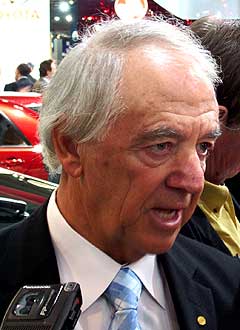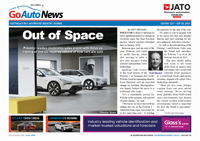Make / Model Search
News - ToyotaToyota powers on the front footPowered up: Toyota revealed the 185kW supercharged V6 Camry TS-01 concept. Toyota Australia outlines plans for new special vehicles unit11 Mar 2005 By TERRY MARTIN TOYOTA Australia is the process of forming a special vehicles operation that will turn out high-performance versions of its Australian-built cars and imported vehicles including the Corolla hatchback and HiLux light commercial. Executive chairman John Conomos said the supercharged 185kW Camry TS-01 unveiled at the Melbourne International Motor Show last week was the sort of vehicle Toyota’s forthcoming go-fast division would create. “What we propose to do with the formation of a new division, a special vehicles operation, is to do this type of thing,” he said. “We’re simply testing public reaction to our early concepts – we are beginning on a journey, which will take a long time, to improve our image through these types of vehicles as part of our image-enhancement program. “Our aggression for the requirement of that type of product, and the realisation that Toyota (Motor Corp) simply cannot meet the demands of each individual country’s special vehicles requirements, (has meant) they’ve in fact improved their support for us in this area – and now we have the blessing of the engineering department we’ll see these sorts of things from now on get a lot more backing from the parent company.” Mr Conomos refused to place a dollar figure on the investment needed to create an Australian SVO unit, however he did confirm Toyota Australia was receiving financial backing from TMC and that a fully-fledged performance arm should be up and running in around 36 months. “We’ll start with the next Camry, the pick-up truck which was revealed here today (HiLux) and probably next off the rank will be Corolla. So those three areas we’ll participate in with local improvements or developments,” he said. According to Toyota Australia chief designer Paul Beranger, a high-performance version of the next-generation Avalon – due late in 2006, a little under 12 months after the all-new Camry arrives – was also under consideration. “Absolutely. Yes. That’s a key part to our future,” he told GoAuto last week. “We’ve had a good opportunity to understand the market with Avalon. We have been limited in what we can do with the car but the future shows that Toyota is going to be much more aggressive in the six-cylinder market with cars like this and the performance side of that market is important to that.”  Mr Conomos (left), and Toyota Australia’s sports conversions and motorsport corporate manager, Greg Gardner, emphasised there was no plan to use all-wheel drive with the Australian-built high-performance cars – a decision that has created difficulties both in engineering and marketing terms. Mr Conomos (left), and Toyota Australia’s sports conversions and motorsport corporate manager, Greg Gardner, emphasised there was no plan to use all-wheel drive with the Australian-built high-performance cars – a decision that has created difficulties both in engineering and marketing terms.“We have no plan to go all-wheel drive – we don’t believe we have any need to do that,” Mr Conomos said. “We believe from our early testing we can get sufficient performance out of our new engine – the next Camry engine – to perform all the requirements that’s necessary. “We’re now testing to see exactly just how much power we can put through the drivetrain.” Mr Gardner said work would also be needed to overcome consumer impressions that front-drive was inferior to AWD or rear-wheel drive. He added that getting the message across that Toyota was a sporting brand would pose some further challenges, too. “Certainly, that’s an issue,” he said. “There is a perception in the market that rear-wheel drive is much better, so that’s something we have to work with … (as will) trying to reinforce the Toyota brand as being sporty. “Over the years, Toyota has been focussing less and less on sporty models – you look at 10 or 15 years ago we had Supra, MR2, Celica and even Paseo, and we’ve over time lost all those particular models. And so what we’re trying to do here is to try and give us more sporty cars and give us a more sporty focus to make us more attractive to a greater range of people. “Currently, we’re number one in the market and number one with the private buyer, but people are predominantly buying it for not-so-emotional reasons – transport, reliability, quality, that sort of thing. We want to try and broaden our range to give them something with more excitement – and to also internally motivate people in the corporation.” Mr Gardner said performance differentiations between the Avalon and Camry versions were still to be determined, though both iterations would be based around the V6 engine and not a souped-up version of the four-cylinder. “The V6 will always have the same power or more power in factory form, so I don’t really see much point in doing a turbo Camry (four),” he said, adding that supercharging was also the preferred form of forced induction for the V6. What the competitors saidWith its forthcoming special vehicles division, Toyota Australia has made it clear it intends to lure customers away from local muscle-car outfits such as Holden Special Vehicles and established Japanese performance outfits like Subaru and its STi offshoot.In developing the Camry TS-01 car revealed in Melbourne last week, Toyota executives also insisted it was a better, more sophisticated car to drive than a V8-powered rear-wheel drive HSV and a turbocharged all-wheel drive Subaru Liberty GT. So what does HSV and Subaru Australia make of Toyota’s move into their territory with a series of high-performance, front-drive road cars – to be based on the next-generation Camry and Avalon and imported vehicles including HiLux and Corolla?HSV sales and marketing director Chris Payne said he welcomed the competition because it would stimulate further market interest in niche performance cars – but he stressed that HSV customers were poles apart from those who might purchase a hotted-up Camry. “The HSV ClubSport customer is that far away from walking into a Toyota dealership, it isn’t funny,” he said, emphasising that a return to a six-cylinder model for HSV was not on its agenda. “Our customers like the V8, rear-drive large-car combination – it’s a pretty simple formula – and I don’t think an HSV customer for one moment would consider front-drive as an alternative to that feel, the driving feel, that our style of car gives. “I wouldn’t underestimate (Toyota’s) resources, everybody knows that, but it’s not just a matter of spending power or clout – it’s really a matter of being smarter to tune into that marketplace and that’s what we believe we’re very good at, and we have over many, many years now been able to feel the pulse of what our customers want. “It’s about listening to what people want, keeping close in with motorsport links – and that’s really intrinsic to what we do. Road cars, race cars. Success on the track, success on the road.” Echoing Mr Payne’s comments, Subaru Australia’s managing director Trevor Amery considered his marque’s racing success and long-held motorsport fan and customer support as marketing advantages that would take Toyota a long time to emulate. He said Subaru attracted different customers to HSV (Subaru customers see performance through technology rather than horsepower) as well as to Toyota. Furthermore, he added that all-wheel drive was among Subaru buyers’ top-five purchase considerations. “Our promise to the customers in terms of what our product’s about, the integrity of the product, the consistency of the product, the all-wheel drive, the boxer engine, the quality of the product – I think those things are recognised by consumers and that’s why people buy those cars from us,” he said. “I wouldn’t suggest that Toyota aren’t capable of creating a performance division out of front-wheel drive cars – I wouldn’t suggest that at all. But I think their customers and our customers are different. “Our customers are buying into the Subaru story. It’s the all-wheel drive, it’s the performance, it’s attached to the rally program, it’s rally world success, it’s testing on some of the toughest roads around the world, it’s about being a little bit different. “It’s very easy to buy into a 20 per cent market share brand – but the people who are buying a three or four per cent market share brand, they’re expressing their individuality.” |
Click to shareToyota articlesResearch Toyota Motor industry news |









Facebook Twitter Instagram